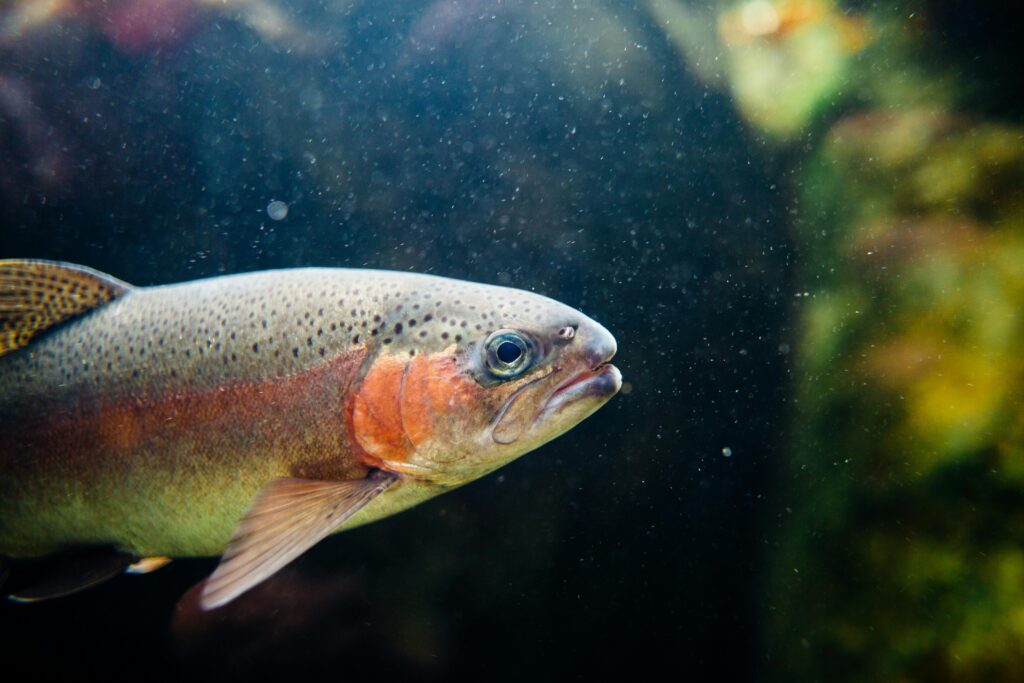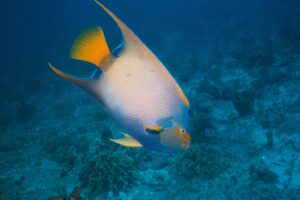discover now which are the 10 freshwater fish

Freshwater fish represent a remarkable spectrum of life that populates waterways from rivers to lakes globally. Exhibiting a vast array of hues, dimensions, and habits, these aquatic inhabitants are pivotal in preserving the intricate web of life, contributing to the richness of species and underpinning the structure of aquatic food webs. From the majestic salmon to the more obscure species, the presence of freshwater fish is indispensable for the health of both our planet’s ecosystems and the economies they influence.
This exploration delves into the top ten freshwater fish, shedding light on their environmental significance, distinctive characteristics, and the role they play in human culture. These creatures are not merely intriguing in their existence; they are also vital barometers for the wellbeing of our environment.
What Makes Freshwater Fish Important ?

Freshwater fish play an indispensable role in maintaining the health of aquatic ecosystems. They are the unsung heroes that keep other species’ populations in check, serve as a vital food source for predators, and are active participants in the circulation of nutrients. Beyond their environmental impact, certain species are also economic powerhouses, bolstering both commercial and recreational fishing sectors. For many communities, these fish are more than just creatures of the water; they embody cultural significance, often representing wealth or serving as emblems of religious faith. The conservation of these species is not just a matter of ecological concern but is also crucial for the continuity of prosperous and sustainable fishing practices. It’s a delicate balance, but one that is essential for the well-being of our planet’s freshwater habitats.
Contents
- 1 1:Salmon (Salmo salar)
- 2 2:Nile Perch (Lates niloticus)
- 3 3:Arapaima (Arapaima gigas)
- 4 4:Catfish (Siluriformes order)
- 5 5:Piranha (Serrasalmidae family)
- 6 6:Tigerfish (Hydrocynus vittatus)
- 7 7:Electric Eel (Electrophorus electricus)
- 8 8:Carp (Cyprinus carpio)
- 9 9:Sturgeon (Acipenseridae family)
- 10 10:Arowana (Osteoglossidae family)
- 11 Conclusion
1:Salmon (Salmo salar)

Salmon, the remarkable migratory fish, undertake an extraordinary odyssey. Born in the tranquil freshwater streams, they venture to the vast ocean, only to return to their natal rivers to reproduce. This cycle is not just a journey; it’s a testament to resilience as they navigate against formidable currents and leap over barriers, all to ensure their offspring are nestled safely in the river’s gravel. These journeys enrich the ecosystems, transferring oceanic nutrients to the riverine habitats, sustaining an intricate web of life that includes predators like bears and birds. Moreover, salmon fisheries constitute a significant economic resource, supporting livelihoods and communities. Their story is one of nature’s most inspiring sagas, a blend of strength, survival, and ecological significance.
2:Nile Perch (Lates niloticus)

The Nile perch, indigenous to the freshwater bodies of Africa, stands as a giant among freshwater fish, with the potential to reach a staggering 200 kg (440 lbs). As a top predator, it plays a crucial role in its natural habitat, regulating the numbers of smaller fish species and thus sustaining the equilibrium of the aquatic food web. Yet, this fish’s introduction into foreign ecosystems, such as Lake Victoria, has disrupted the ecological harmony, positioning the Nile perch as both a valuable target for fishermen and a contentious figure in environmental discussions.
3:Arapaima (Arapaima gigas)

The Arapaima, often referred to as pirarucu, ranks among the titans of freshwater fish, hailing from the vast Amazon Basin. These behemoths can stretch beyond 2 meters and tip the scales at a hefty 200 kilograms. Remarkably, Arapaima have evolved to thrive in waters with low oxygen levels, thanks to their unique swim bladders that enable them to gulp air from the surface. As apex predators, they are crucial in maintaining the balance of their ecosystem by regulating the numbers of other fish species. Beyond their ecological role, Arapaima are indispensable to the local populace, serving as a significant food resource.
4:Catfish (Siluriformes order)

Catfish, a varied collection of freshwater fish, inhabit waters across the globe. They are easily recognized by their unique barbels, akin to the whiskers of a cat, and vary greatly in size. The Mekong giant catfish, for instance, can reach impressive sizes, whereas many others remain small, scouring the riverbeds. Remarkably adaptable, catfish can flourish in diverse aquatic settings. They hold considerable value for local fishing communities and are pivotal in extensive aquaculture ventures, providing a crucial dietary staple.
5:Piranha (Serrasalmidae family)

Piranhas, often depicted as ferocious creatures, actually possess a more nuanced nature. These fish, with their razor-like teeth and formidable bite, have garnered a notorious reputation. However, they hail from the rivers of South America and are, in reality, more often scavengers than the aggressive hunters of popular imagination. Their role in the ecosystem is a vital one; they contribute to the balance by consuming carrion and thus, help sustain robust fish communities. Beyond their ecological importance, piranhas hold a place in the cultural tapestry of the regions they inhabit and are even utilized in research within controlled settings. This reimagined perspective on piranhas invites a broader understanding and appreciation of their true behavior and significance.
6:Tigerfish (Hydrocynus vittatus)

The African tigerfish, a formidable predator in the freshwater realms of Africa, is distinguished by its voracious hunting habits and razor-like dentition, adept at capturing its piscine prey. Inhabiting the continent’s myriad rivers and lakes, these tigerfish are coveted by fishing enthusiasts for their remarkable agility and robustness. Occupying the apex of the food chain, they play a crucial role in maintaining the equilibrium of fish communities, thus ensuring the health of their aquatic habitats. It is their relentless pursuit of prey and their striking visage that solidify their status as one of the most intriguing inhabitants of Africa’s inland waters.
7:Electric Eel (Electrophorus electricus)

Contrary to what its name might suggest, the electric eel is actually a type of knifefish found in the Amazon and Orinoco river systems. This fascinating creature has the ability to produce potent electric shocks, a skill it employs for predation and protection. The electric eel is a masterful predator, uniquely evolved to flourish in dim, low-oxygen waters, utilizing its electric capabilities for orientation and interaction. These fish play an essential role in preserving the ecological equilibrium of their indigenous regions.
8:Carp (Cyprinus carpio)

Carp, a fish that has traversed continents and cultures, holds a place of economic and ecological prominence across the globe. Native to the vast and varied waters of Asia, these resilient fish have found their way into lakes, rivers, and ponds worldwide, thanks to human intervention. Their introduction has been driven by the dual desires of promoting aquaculture and enhancing recreational fishing experiences.
The adaptability of carp is nothing short of remarkable. They thrive in a multitude of aquatic settings, from the gentle flow of a river to the stillness of a pond. This versatility, however, comes with its challenges. In certain locales, carp have upset the ecological balance, earning the label of an invasive species. Yet, in other parts of the world, they are celebrated for their tenacity and have woven themselves into the cultural fabric, especially within East Asian culinary traditions.
The story of carp is a testament to the interconnectedness of our world’s ecosystems and the profound impact human actions have on them. As we continue to shape our natural environment, the journey of the carp serves as a reminder of the delicate balance we must maintain. Whether viewed as an unwelcome intruder or a valued member of the aquatic community, the carp’s global odyssey is a narrative rich with lessons and reflections on our relationship with nature.
9:Sturgeon (Acipenseridae family)

Sturgeons, the venerable denizens of the deep, have traversed our waters for over 200 million years. These grand, leisurely-paced swimmers are celebrated for their caviar—a delicacy synonymous with opulence and culinary prestige. Inhabiting both the tranquil freshwater bodies and the vast marine expanses, they undertake an upstream journey to their spawning grounds in rivers. Yet, this ancient lineage faces a dire threat: numerous sturgeon species stand on the brink of extinction, imperiled by overharvesting and the degradation of their natural habitats. Initiatives for their preservation are in motion, aiming to safeguard these noble creatures for future generations.
10:Arowana (Osteoglossidae family)

Arowanas, the venerable denizens of freshwater realms, boast a lineage as ancient as the waters they inhabit. Adorned with grandiose scales and bodies that stretch like the rivers they call home, these fish are known for their remarkable agility, leaping from the water with grace to ensnare their prey. In the diverse waters of South America, Southeast Asia, and Africa, arowanas are not merely fish but emblems of prosperity, cherished in many Asian traditions. As adept hunters, they maintain the delicate balance of their ecosystems, reigning in populations of insects and smaller fish. Yet, the survival of some arowana species hangs in the balance, imperiled by the dual threats of vanishing habitats and the relentless pursuit by the ornamental fish industry.
Conclusion
The variety of fish inhabiting freshwater is truly remarkable, encompassing a spectrum from the fierce piranha to the tranquil carp. Each type of fish fulfills a distinct role within its habitat, which is vital for maintaining the equilibrium and vigor of freshwater realms. The encroachment of human endeavors poses risks to numerous species, making the preservation of these aquatic communities through conservation measures imperative. It is of utmost importance to comprehend and safeguard these extraordinary creatures to secure the continuity of freshwater biological diversity.




